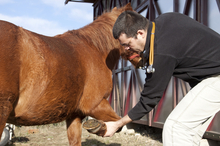Equine Lameness - A Definition

Lameness is any abnormality of the horse's gait that is caused by pain or restriction of movement. Such abnormalities may be caused by pain in the back, shoulders, withers, neck, loin, hips, legs, feet, or other factors that affect the horse.
Equine Lameness - A Dynamic Event
Lameness is a dynamic rather than a static event and needs to be examined under a variety of conditions to fully assess the horse's capabilities since a horse may not show the same grade of lameness under different circumstances.
The degree of lameness may vary depending on the ease or difficulty of movement, the stage of the movement or exercise, and the cause of the lameness. A horse that is walking around in a pasture may not appear to be lame, but, with a rider on it's back, may show significant lameness when urged into a trot or canter.
Difficulty of terrain or different kinds of surfaces may impact the grade of lameness. A horse may show no evidence of lameness on a soft, smooth surface, but show a high degree of lameness on rough, hard terrain.
The horse needs to be observed carefully to see if the lameness worsens, stays the same, or improves under different conditions and with varying degrees of exercise.
The evaluation process and comprehensive lameness examination requires patience by the horse owner and veterinarian. Cases of lameness may take several days to investigate and are even more difficult to evaluate once the lameness becomes chronic.
Is it lameness or a neurological disease?
Another consideration for the veterinarian is whether the apparent lameness might indicate a neurological disease caused by spinal cord damage, especially if it is mild. Horses with neurologic disease often move and carry themselves abnormally causing painful orthopedic conditions as the horse attempts to compensate.
Neurological diseases such as Wobbler Syndrome and Equine Protozoal Myeloencephalitis, trauma, and other diseases and conditions can cause severe neurological deficits that result in performance problems and lameness.
Horses, particularly those with chronic problems, may develop compensatory gait abnormalities to deal with the primary problem making diagnosis more difficult. This may complicate the lameness evaluation and possibly its treatment. Therefore, it is important to have both the lameness and the indications of any neurological problems evaluated as soon as they are recognized.
The veterinarian's examination procedures

The lameness exam
A systematic lameness exam is used to isolate the area of pain so that effective treatment plan can be implemented.
Most experienced veterinarians have developed systems for examining horses for lameness based on the reasons for the evaluation.
Prior to a veterinarian's examination to diagnose the causes of lameness, the horse should be off any pain medications for at least 24 hours. This includes Bute or Banamine, etc.
Examination procedures may include the following, as deemed appropriate for the situation:
- Taking a medical history
- A careful examination of the feet of the horse since nearly 90% of lameness occurs in the foot. The veterinarian will also evaluate the trimming of the hooves, the shoeing, and may remove the horse's shoes to more carefully observe all areas of the foot.
- A physical examination of the horse using palpation and manipulation of muscles, joints, bones, and tendons, joint flexion tests, and application of hoof testers to reveal evidence of injury or stress. Part of the evaluation includes the veterinarian holding each of the horse's limbs in a flexed position, then releasing the leg.
- The physical examination will also appraise conformation, weight-bearing, and balance.
- An evaluation of the horse in motion with particular attention paid to any deviations in gait, failure to use all four feet in sync, unnatural shifting of weight from one limb to another, head bobbing, stiffness. As the horse trots away, the veterinarian watches for signs of pain, weight shifting, shortening of stride, and irregular hoof placement.
- A neurologic examination should be part of the workup since conditions such as Wobblers Syndrome and Equine Protozoal Myeloencephalitis (EPM), as well as trauma and other diseases can masquerade as lameness.
- A blood test to detect drugs that may camouflage lameness or that might contribute to the lameness.
- X-rays (radiographs) to identify damage or changes in bony structures.
- Analgesic techniques, including diagnostic regional nerve and joint blocks, to identify the location of the injury or stress that is causing the lameness. Working from the foot up, the veterinarian temporarily deadens sensation in specific parts of the limb, one joint at a time, until the lameness disappears. This procedure isolates the area of pain causing the lameness and also helps determine whether the condition is treatable.
- Ultrasonography, nuclear scintigraphy (bone scan), or magnetic resonance imaging (MRI) to look for soft-tissue problems involving tendons, ligaments, joint surfaces, and muscle tissue. Computer tomography (CT) may be used for both tissue and bone problems.
- Samples of blood, synovial (joint) fluid, and tissue taken for examination to determine if infection or inflammation are present. These tests usually require laboratory evaluation before results are available.
In some cases, one or two of these steps in the examination of lameness may allow the veterinarian to make a diagnose and determine treatment. In other cases, all of these factors will need to be considered and additional steps taken based on the over-all condition of the horse, the severity of the lameness, and the horse owner's plans for the horse.

Diagnosing Lameness
Lameness is a complex condition, and the extent of the examination and evaluation will usually relate to what the owner plans to do with the horse.
A thorough lameness workup with the development of related rehabilitations regimens can be complicated and time-consuming. Owners should make sure they understand what is causing the lameness, the prognosis for recovery, and the medications, exercises, therapies and other requirements to restore the lame horse to its best possible condition.
The horse owner should follow the veterinarian's instructions and be willing to comply with requests for follow-up exams. In most cases, the horse will need rest during treatment and possibly for some time afterward. Making sure that the veterinarian's instructions are discussed, understood and followed will help insure that the horse gets the best care possible.
How veterinarians grade horse lameness
Because each horse has individual characteristics, evaluating lameness can be challenging. The American Association of Equine Practitioners has developed a lameness scale that ranges from zero to five, with zero being no perceptible lameness, and five being extremely lame:
- Lameness not perceptible under any circumstances
- Lameness is difficult to observe and is not consistently apparent, regardless of circumstances (e.g., weight carrying, circling, inclines, hard surfaces, etc.)
- Lameness is difficult to observe at a walk or when trotting in a straight line, but consistently apparent under certain circumstances (e.g., weight carrying, circling, inclines, hard surfaces, etc.)
- Lameness is consistently observable at a trot under all circumstances
- Lameness is obvious at a walk
- Lameness produces minimal weight-bearing in motion and/or at rest or a complete inability to move
Lameness is a complex condition, and the extent of the examination and evaluation will usually relate to what the owner plans to do with the horse. If the horse is more of a pasture ornament and ridden only occasionally, the veterinarian may not recommend all the diagnostic tests that can add to an exam's cost, especially if the schedule allows for plenty of pasture time, along with the right amount of exercise to allow healing of the structures that contribute to the lameness.
On the other hand, if the horse is a competitive performance horse, the value, intended use of the horse, and long-term goals may make the most advanced tests absolutely necessary to provide the most comprehensive picture of the horse's condition. The veterinarian can then prescribe treatment and give a reasonable estimate of the time needed to rest the horse before returning to an active schedule.
Dig deeperTM
If you enjoyed this, you will probably also like to read other articles in our lameness health center.
